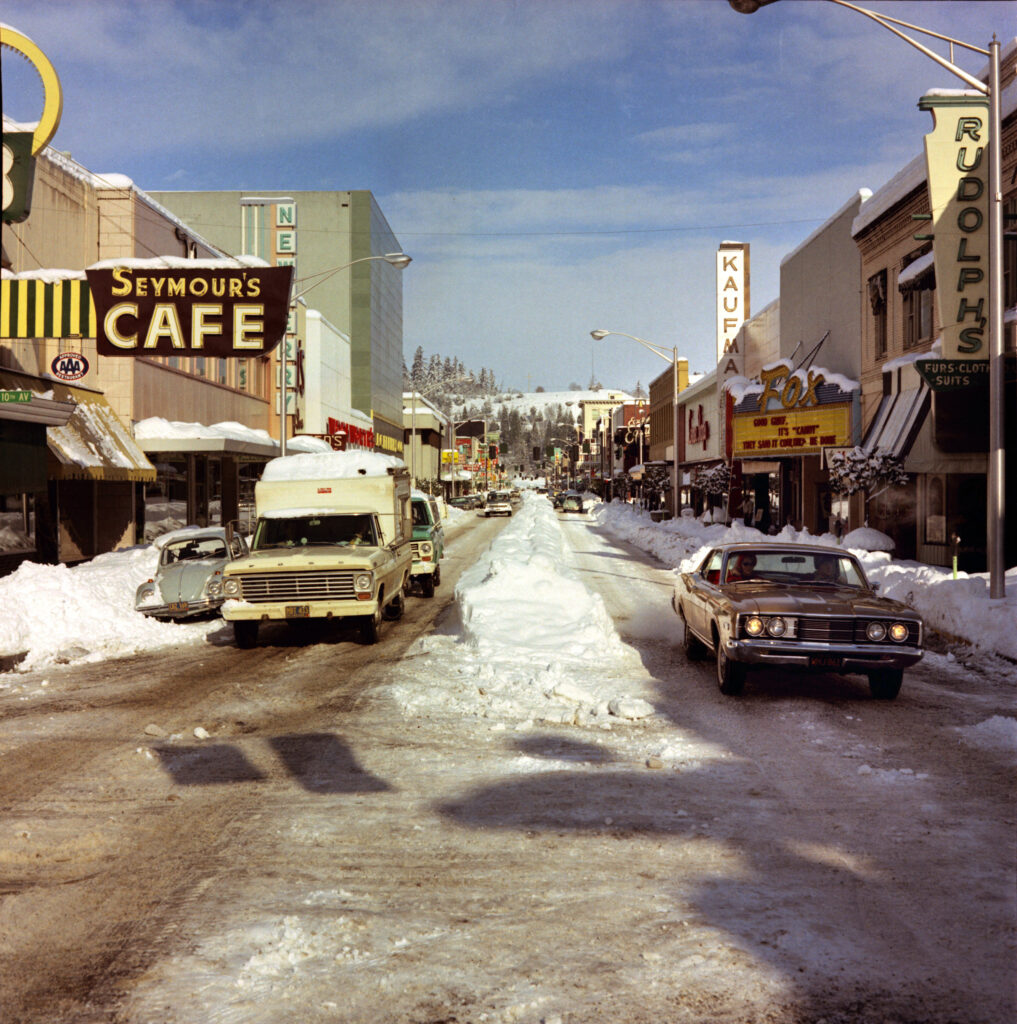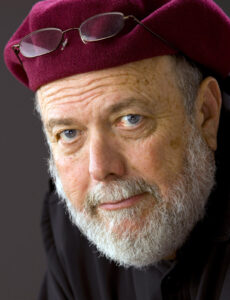An escaped killer, Elvis – and the ‘Big Snow’

1967-1977
By Mark Baker
For The Register-Guard
Anti-war protests and bombings at the University of Oregon. The “Big Snow.” “Black Tuesday.” A Pulitzer-winning photographer. An escaped cop killer. The U.S. Olympic Track & Field Trials. The sudden death of a distance-running legend. Elvis Presley at “The Pit.”
Yes, they were all part of this colorful decade.
The “Big Snow” began falling about 5:40 a.m. on Jan. 25, 1969, and didn’t stop until 3:30 a.m. Jan. 27. A total of 37.9 inches fell in three days. Many trucks trying to get the Sunday morning Jan. 26 newspaper – with the headline “Record Snow ‘Whites Out’ Eugene” – to Register-Guard newspaper carriers, got stuck. Subscribers got the paper late or the next day on several days.
Valley River Center opened on Aug. 4, 1969, forever changing shopping in Eugene and helping, many believe, cause significant damage to shopping in downtown Eugene. The ill-fated Eugene Mall didn’t help matters, as jackhammers began tearing up the sidewalks on Willamette Street on May 4, 1970, and the mall – complete with a concrete fountain in the middle at Willamette Street and Broadway – was dedicated in February 1971.

Other high-profile stories of this era included field burning; the smoke from grass-seed farms between Albany and Cottage Grove grew so thick on Aug. 12, 1969, that the day is known as “Black Tuesday.”
Gov. Tom McCall stood atop Skinner Butte with Eugene Mayor Les Anderson and ordered the Oregon Environmental Quality Commission to meet in Eugene the next day and devise new field-burning rules. But grass-seed farmers fought them, successfully, for years. It would take a tragedy two decades later, the deaths of seven motorists on Aug. 3, 1988, on Interstate 5 south of Albany, when smoke from an out-of-control field burn caused a chain-reaction pileup of 23 vehicles, to get the conversation started again. And the state would not ban field burning until 2009.
Famed local author Ken Kesey wrote an Aug. 15, 1971, Register-Guard op-ed piece titled “A letter from the Coburg Hills,” after viewing field burning from up high for the first time:
“The smoke rose in mighty murky pillars, into spectacular thunderheads all knobby and propenderous [sic], like great yellow-brown puffed lips or punk knots swelling from an injured land, then all the separate pillars joined into one great bruise that began creeping the width and length of the valley.”
And then there were the Vietnam War protests, bombings and other violence at the University of Oregon from 1967 to 1970. On Feb. 16, 1970, arsonists set fire to the physical education building and an ROTC storage room at 15th Avenue and University Street, causing $250,000 damage as 3,000 watched firefighters douse the flames.
On April 24, 1970, 10 days before Ohio National Guardsmen shot four students dead at Kent State, 63 people were arrested for disorderly conduct at the UO’s Johnson Hall.
And, of course, the early ’70s brought a young man named Steve Prefontaine to the UO from Coos Bay. He would thrill Hayward Field crowds, shatter distance-running records and make the 1972 U.S. Olympic team, after the first of three straight Olympic Trials at the UO’s Hayward Field.
Pre would finish fourth in the 5,000 meters at Munich, barely missing a medal, as Register-Guard sports columnist Blaine Newnham was there to cover it on Sept. 10, 1972, just five days after Palestinian terrorists slaughtered 11 Israeli athletes.
“The ironies of this week are considerable,” Newnham wrote. “The deaths of Israelis on land that once served as the landing field where Neville Chamberlain touched down to negotiate with Hitler for peace in our time. And less than 10 miles from Dachau, and the museum reminding Germany of the six million Jews it killed during World War II.”
But perhaps the biggest story locally, during this era, was that of Carl Cletus Bowles.
“It was a wild time,” says Don Bishoff, who retired from The Register-Guard in 1999 after 39 years as a reporter, editor and columnist. “It was just very strange. Other than the killing (of Lane County sheriff’s deputy Carlton Smith, also at the hands of Bowles), that would have to be the highest ranking (story he ever worked on).”
Bishoff is talking about what happened in a quiet south Eugene neighborhood on June 14, 1974.
“Bullets fly in S. Eugene manhunt,” read the banner headline of that afternoon’s Register-Guard, the story co-bylined by Bishoff, then an assistant city editor, and police reporter Don Mack.
Bowles, 33, had escaped from the Oregon State Penitentiary a month before after he was given a four-hour social pass to visit his girlfriend/niece at a Motel 6 in Salem, despite serving two consecutive life sentences for the 1965 murder of Smith during a traffic stop on Delta Highway.
A tip led two FBI agents to encounter Bowles walking in the 3400 block of Willamette Street near Dunn Elementary School, that Friday morning in June 1974. Shots were exchanged, and Bowles fled on foot. The entire area was blocked off as helicopters flew overhead and homes were searched.
Bowles escaped the area, taking two hostages, Earl Hunter, 63, and his wife, Viola, 61, of East 48th Avenue, with him. He was caught a couple of days later, shot by police in pursuit near Coeur d’Alene, Idaho, and the Hunters’ bodies were found, shot to death, in mid-July.
The Register-Guard stayed on the story throughout, winning the Oregon Newspaper Publisher Association’s “Best Story” of the year award. Bowles went back to prison, where he died in 2005.
In fact, the Register-Guard would win the ONPA’s “General Excellence” award as the state’s best newspaper a dozen times in 15 years between the late 1960s and the early 1980s.

Those were the paper’s “glory years,” Bishoff recalls, when resources seemed unlimited, when future Pulitzer winners such as Doug Bates and Jacqui Banaszynski were on staff, and when the addition of a 27-year-old photographer, hired from the Topeka (Kan.) Capital-Journal, in December 1974, helped take the Guard to a new level.
Brian Lanker, winner of the 1973 Pulitzer Prize for feature photography, served as the paper’s graphics director for eight years while also working full time as a photographer (He was twice named national photographer of the year by the National Press Photographers Association). He helped redesign the newspaper’s look, an impact that continues four decades later, with award-winning photography and page design that’s among the best in the business.
Lanker’s haunting photograph of Prefontaine’s pre-race gaze, snapped on May 29, 1975, just hours before Pre was killed in a single-car crash on Eugene’s Skyline Boulevard, will endure as long as the great athlete’s legend.
Mark Baker, who researched and wrote the stories for this special section, is a former Register-Guard reporter and a member of the third generation of the Baker family.

Mark Baker has been a journalist for the past 25 years. He’s currently the sports editor at The Jackson Hole News & Guide in Jackson, Wyo.
